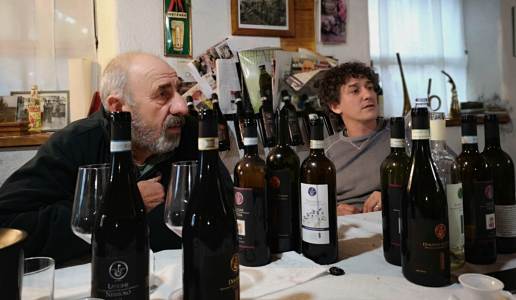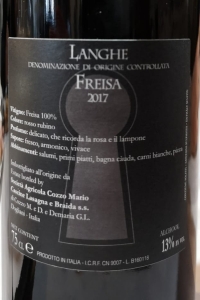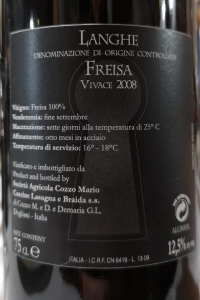Cozzo Mario and vanishing Freisa wines

Should you be fortunate enough to come across a Freisa wine, savor it with double pleasure, for both its enjoyability and its rarity.
We wrote about this small estate with an in-depth look at its Dogliani DOCG. Today, however, we would like to tell you a story and by doing this tell you about one of their wines and a grape that, for me, is particularly important beyond its intrinsic merits: Freisa.
After I tasted their Dogliani, I phoned the estate to know more and find out who was behind these wines. Gian Luca Demaria told me they also produced a thousand or so bottles of sparkling Freisa, made in an autoclave, which Uncle Mario, the estate’s patriarch, was particularly fond of. Just hearing the name of that wine brought back some wine memories from my youth, when I drank all types and qualities of Freisa, from the most simple to the rare and famous ones. I immediately asked Gian Luca to send me a couple of bottles so I could taste them and in the middle of last summer I received two bottles which I let rest in my cellar to overcome the stress of travelling.
A few days later I took one out and put it in my refrigerator and this because Freisa should be drunk cool, not cold, because at room temperature it doesn’t deliver as much. While some of you may be shocked, keep reading and you’ll understand why I was right to do so. Coming back from a day at the beach, my girlfriend and I were hungry and thirsty. And so I took the bottle out of the fridge along with some salami and cheese and then went to take a shower. When we sat down to drink this Freisa, which was no longer cold but wonderfully cool, it seemed to finish in an instant along with the tidbits. You can read the tasting notes later but I can tell you now that a Freisa so “uncouth”, fresh, acidic, flavorful and slightly tannic was devastatingly enjoyable.
I have coined a phrase, an adjective for this type of Freisa which may not be that original: “wild-like”. Other Freisa are also very good, the softer, rounder and graceful ones that perhaps pair well with more sophisticated foods, even cooked ones. In other words, I think that Freisa is an excellent wine to pair with food, a table wine. Unfortunately, Freisa wines, all of them, the wild ones and non, are vanishing.
I recently visited the estate in Dogliani where, during a family meal, I chatted with Gian Luca’s Uncle Mario who confirmed I should cool Freisa un the fridge. He also told me that in Dogliani alone there are at most five producers of Freisa and it was quickly vanishing in the Langhe, a victim of what I consider the dangerous trend towards the single-cultivation of Nebbiolo. Gian Luca made things even worse when he told me that only a few restaurants in Turin now even had Freisa on their wine list and so the future of this valorous varietal was sadly doomed.
I believe – as do all my DoctorWine friends – that this agricultural impoverishment should be opposed with all means possible. By the same token, I think that those producers who rightfully see themselves as noble defenders of the land against modern speculation, should take a close look at themselves and decide whether the direction they have taken is the right one or whether they should also invest in also cultivating Freisa, perhaps even planting some new vines, and add its wines to their lines and even promote them. I say this because I am convinced that Freisa is a very modern wine, not too alcoholic, something to drink cool and sparkling, something different that has a vast potential of consumers. All things considered, isn’t this a battle worth fighting for?
I am obviously not calling for a wine crusade but only underscoring, with the passion and pathos I am known for, that the Langhe without this and other local varietals like it is an impoverished and less attractive land. And so my producer friends, think about this. And should you decided to invest in these varietals, do so in your own way, the way you think best. Nevertheless, we are not talking here about one type of Freisa but everything it makes!
 Langhe Doc Freisa Vivace 2017
Langhe Doc Freisa Vivace 2017
Made from only Freisa grapes and macerated on the skins for seven days at 25°C after which the wine spends a couple of days in an autoclave to reach an atmospheric pressure of 0.5-0.7 before maturing in stainless steel vats for eight months. The wine has a dark, red-ruby color with intense and fresh aromas of flowers and wild berries. The mouthful is saline, dry, direct and slightly tannic with an inviting freshness that combines with a soft vivacity that makes this a compulsive drop, an excellent companion with food.
91/100
€ 8,50
 Langhe Doc Freisa Vivace 2008
Langhe Doc Freisa Vivace 2008
Made from only Freisa grapes and macerated on the skins for seven days at 25°C after which the wine spends a couple of days in an autoclave to reach an atmospheric pressure of 0.5-0.7 before maturing in stainless steel vats for eight months. The color is an intact and dark ruby-red and the fresh aroma is one of flowers and wild berries with a hint of spice. Even though the wine is ten years old, the mouthfeel is still vivacious, dry and direct with polished tannins and a persistent and surprising freshness and vivacity Practically immortal!
93/100
Impossible to find, this bottle was once of the few left at the estate
Related Products
| Product | Producer | Date of publication | Author | Read | |
|---|---|---|---|---|---|

|
Freisa Vivace 2017
Langhe |
Cozzo Mario | 01/30/19 | Vignadelmar |
Made from only Freisa grapes and macerated on the skins for seven days at 25°C after which the wine spends a couple of days in an autoclave to reach an atmospheric pressure of 0.5-0.7 before... Leggi tutto |

|
Freisa Vivace 2008
Langhe |
Cozzo Mario | 01/30/19 | Vignadelmar |
Made from only Freisa grapes and macerated on the skins for seven days at 25°C after which the wine spends a couple of days in an autoclave to reach an atmospheric pressure of 0.5-0.7 before... Leggi tutto |

|
Cozzo Mario
|
09/12/18 | Redazione |

 Italiano
Italiano






